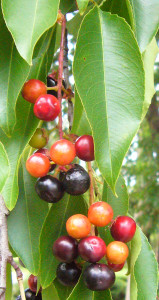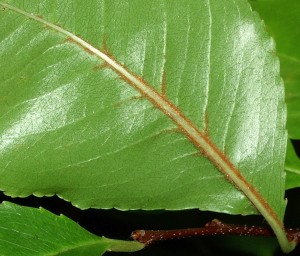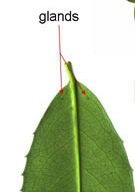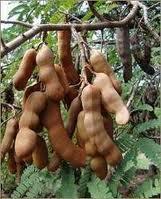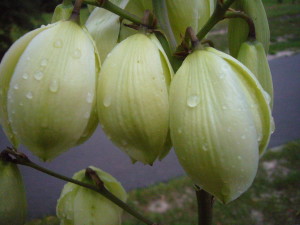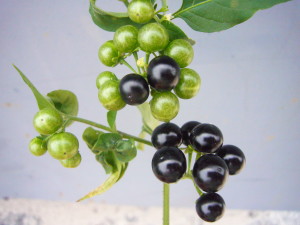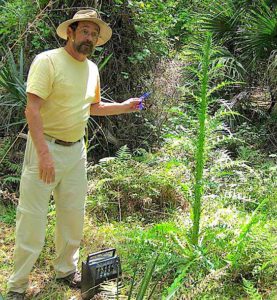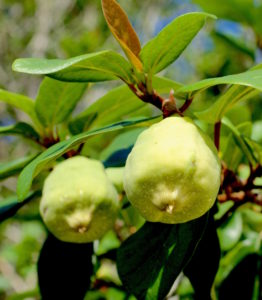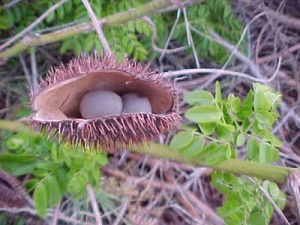Sporadic rain and fluctuating temperatures can alter plant schedules. Already this year Surinam Cherries have been unpredictable, full fruit in some place, just starting in others, gone elsewhere. Also ripening rough shod is Black Cherry, the only true cherry we find locally (Surinam Cherries are actually in a different genus.)
Black Cherries are both sweet and bitter at the same time. They can be eaten out of hand and made into a variety of products. Black Cherry cough syrup, however, is made from the cambium not the fruit. In the past three weeks I’ve seen trees totally laden with fruit and others still with unripe green fruit. The ripening time is proving to be uneven. While that might make ripe fruit harder to find it also could also extend the harvesting season a few weeks. To read more about the Black Cherry go here.
Black Cherry vs Cherry Laurel: While on the topic of cherries this is an opportunity to highlight the differences between the edible wild Black Cherry and deadly wild Cherry Laurel, both native. The fruit of the Black Cherry (Prunus serotina) is edible when ripe. The fruit of the Cherry Laurel (Prunus caroliniana) is always toxic. A quick look at the leaves can tell them apart. The Black Cherry, right, has consistently small teeth around the entire edge of the leaf. And if you look at the backside of the leaf the main stem near the base will have hair on both sides for about an inch. This time of year the hair can be white but it will change to light tan and then dark brown as the season progresses. The soft Black Cherry fruit is dark red to purple with a dimple in the end.
The Cherry Laurel leaf, left, is quite different. Its teeth are sporadic, especially on older trees or older leaves can have no teeth at all. Younger leaves can have many teeth but they are not consistent or well-organized. Also the back of the Cherry Laurel leaf does not have any hair along the stem. Instead it often has two gray-green dots near the base. They can be faint but each leaf usually will have those dots, which are really glands. They also are not in the exact same spot all the time and on very young leaves can be red. Cherry Laurel leaves also smell of almonds or maraschino cherries when crushed which is cyanide (assuming you are among those who can smell cyanide. Many people cannot.) The fruit of the Cherry Laurel is hard, dark blue to black and pointed. NOT EDIBLE.
Although it may sound odd the Black Cherry tree also looks like more like a typical cherry bark being more checkered than the Cherry Laurel. I have read there are Pin or Red Cherries growing in Florida but the only edible one I’ve ever see here is the Black Cherry. I grew up in Maine where we harvested choke cherries to make jelly and wine…. we also suffered trying to eat them raw.
One of the more pleasant aspects of teaching foraging in Florida — and one of the headaches — is huge climate differences and subsequent plant species. The state ranges from temperate forest to tropical. Between temperate and subtropical one can find the Tamarind tree.
Tamarindus indica is from warm Africa. Today it is commonly found in South Asia and Mexico. India is the world largest producer of the legume. Tamarind’s nutritious pods are consumed raw and cooked and is one of the current flavor darling of many avant-garde restaurants. The flavor is distinctive, both sweet and sour. The tree itself is slow-growing and long-lived. Without the pods it’s just another pea tree, of which there are so many here in Florida. I see it regularly when I teach in West Palm Beach. Without its annual pods the tree can easily hide, moderate in size, not too distinct. The other interesting part is that most trees in the greater legume group are toxic with some notable exceptions, the Tamarind being one and the Eastern Red Bud another. Generally pea trees don’t offer much to the forager.
Also blossoming now are our local yucca, Yucca filamentosa. While some wild edibles are under rated perhaps the Yucca is over-rated. You will read in many foraging books that the blossoms are edible raw. Good luck with that. I have never found that so with our local species. Raw they have a wonderful texture and initial flavor but then a natural soap kicks in and leaves a bitter aftertaste that is quite disappointing. Cooked flowers, however, are quite tasty though you always have to knock out a lot of insects before cooking… well, you don’t really if you want some extra protein. I usually boil the blossoms. The flower spike is also edible when very young. Other parts are famine food. To read more about the yucca go here.
Also fruiting now is the controversial American Black Nightshade, Solanum americanum. Several genera have one foot in edible and the other in toxic. The Nightshade is one such family, as is the Honeysuckle and the aforementioned Peas. I eat S. americanum berries as a trail side nibble often to the aghast of students or even other foragers. It’s a family with a lot of misunderstanding but also justified warnings about toxicity. If I have a problem with the S. americanum it is that the fruit is not consistent. Sometimes you find some very ripe but bitter fruit. Don’t eat those. Sometimes that are also larger than usual fruit and bitter (something I have noticed in the species in Ocala.) Perhaps there is some cross pollinating going on. Always taste a ripe berry first and wait a minute or two to see if any bitterness shows up. The green berries are definitely toxic. Do not eat them. To read more about the American Nightshade go here.
FORAGING CLASSES: Heading north this week for a foraging class in Gainesville at Boulware Spring. This location is close to the Hawthorne Bike Trail which we will also walk on for a ways. It’s one of the few places in Florida I have found Partridge Berries and also Chicken of the Woods mushrooms. Sometimes we get a glimpse of a surrogate deer mother, a partially blind deer on site that raises orphaned fawns. If lucky we might also find some end of season wild garlic.
Saturday, May 27th, Boulware Springs Park, 3420 SE 15th St., Gainesville, FL 32641. 9 a.m. Meet next to the spring house.
Sunday, June 4th, John Chestnut County Park: 2200 East Lake Road, Palm Harbor, FL 9 a.m. 34685.
Sunday, June 11th, Bayshore Live Oak Park, Bayshore Drive. Port Charlotte. 9 a.m. Meet at the parking lot at the intersection of Bayshore Road and Ganyard Street.
Saturday, June 17th, Florida State College, south campus, 11901 Beach Blvd., Jacksonville, 32246. 9 a.m.
Sunday, June 18th, Blanchard Park, 10501 Jay Blanchard Trail, Orlando, FL 32817. 9 a.m. Meet east side of the tennis courts near the YMCA building.
To read more about the foraging classes go here.
Want to identify a plant? Looking for a foraging reference? Do you have a UFO, an Unidentified Flowering Object you want identified? On the Green Deane Forum we chat about foraging all year. And it’s not just about warm-weather plants or just North American flora. Many nations around the world share common weeds so there’s a lot to talk about. There’s also more than weeds. The reference section has information for foraging around the world. There are also articles on food preservation, and forgotten skills from making bows to fermenting food. One special section is “From the Frightening Mail Bag” where we learn from people’s mistakes. You can join the forum by clicking on the button on the upper right hand side of this page.
All of Green Deane’s videos available for free on You Tube. They do have ads on them so every time you watch a Green Deane video I get a quarter of one cent. Four views, one cent. Not exactly a large money-maker but it helps pays for this newsletter. If you want to see the videos without ads and some in slightly better quality you can order the DVD set. It is nine DVDs with 15 videos on each. Many people want their own copy of the videos or they have a slow service and its easier to order then to watch them on-line. They make a good gift for that forager you know. Individual DVDs can also be ordered. You can order them by clicking on the button on the top right of this page or you can go here.
From the Archive 2012
It was a road tour weekend with a Saturday class in Port Charlotte and West Palm Beach on Sunday. Round trip it was a total of 533 miles for the weekend on the big red motorcycle. I always enjoy these two locations because they have species not found even 200 miles to the north.
In Port Charlotte we saw a gray Nickerbean, Caesalpinia bonduc. It’s included among the “sea beans” that float north on ocean currents from Central and South America. However, the gray Nickerbean — aka Nickernut — is actually a Florida native. I have not found any reference to this legume vine being edible however the seeds have been used medicinally for many applications. As the plant was used extensively to combat malaria, it’s also been called the “quinine of the poor.” The non-edible seeds float and stay viable for at least 30 years. They have been found as far away as Scotland where they are called Molucca Beans. Oddly the Scots call all sea beans that come ashore arna Moire, or in Gaelic, Mary’s Kidney. One relative of the Nickerbean is edible. That is the C. pulcherrima, whose young seeds are eaten fresh or cooked. The flowers of that species are edible after cooking. The stamens of C. gilliesii flowers are used to adulterate saffron. Interestingly the Nickerbean is related to the Bauhinias.
This is issue 258
If you would like to donate to Eat The Weeds please click here.

